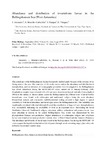Mostrar o rexistro simple do ítem
Abundance and distribution of invertebrate larvae in the Bellingshausen Sea (West Antarctica)
| dc.contributor.author | Ameneiro, Julia | |
| dc.contributor.author | Mouriño-Carballido, Beatriz | |
| dc.contributor.author | Parapar, Julio | |
| dc.contributor.author | Vázquez, Elsa | |
| dc.date.accessioned | 2016-11-29T16:28:47Z | |
| dc.date.available | 2016-11-29T16:28:47Z | |
| dc.date.issued | 2012 | |
| dc.identifier.citation | Ameneiro, J., Mouriño-Carballido, B., Parapar, J. et al. Polar Biol (2012) 35: 1359. doi:10.1007/s00300-012-1177-4 | es_ES |
| dc.identifier.issn | 1432-2056 | |
| dc.identifier.uri | http://hdl.handle.net/2183/17643 | |
| dc.description.abstract | The central part of the Bellingshausen Sea has been poorly studied, partly because of the presence of ice during most of the year. The main aim of this study was to analyse the abundance and distribution of meroplankton, and the influence of oceanographic properties were investigated in the Bellingshausen Sea (West Antarctica) during the BENTART-06 cruise carried out in January–February 2006. Zooplankton samples were collected with a 80-μm mesh plankton net hauled vertically from a depth of 200 m to the surface at fifteen stations across the Bellingshausen Sea. Fifteen types of larval benthic invertebrates were found, with echinospira and nudibranch veligers being the most abundant. Hierarchical analysis and non-metric multidimensional scaling revealed a high degree of spatial variability in both larval abundance and larval types across the Bellingshausen Sea. The variability was significantly correlated with total chlorophyll-a and the contribution of large (>5 μm) phytoplankton to total chlorophyll, indicating the availability of food as an important factor determining the larval distribution observed. Nudibranch veligers, nemertean pilidia, echinoderm and planula larvae were more abundant at stations in the central Bellingshausen Sea, which was characterized by low phytoplankton biomass and production. Higher abundances of echinospira veligers and polychaete larvae were found at the more productive stations close to Peter I Island and the Antarctic Peninsula. The abundance and diversity of larval types found in the Bellingshausen Sea during the BENTART-06 cruise support the hypothesis that indirect development through larval swimming stages plays a key role in benthic recruitment in polar areas. | es_ES |
| dc.description.sponsorship | Ministerio de Ciencia y Tecnología; CGL2004-01856 | es_ES |
| dc.language.iso | eng | es_ES |
| dc.publisher | Springer | es_ES |
| dc.relation.uri | http://dx.doi.org/10.1007/s00300-012-1177-4 | es_ES |
| dc.rights | The final publication is available at Springer via http://dx.doi.org/10.1007/s00300-012-1177-4 | es_ES |
| dc.subject | Bellingshausen Sea | es_ES |
| dc.subject | Antarctica | es_ES |
| dc.subject | Invertebrate larvae | es_ES |
| dc.subject | Distribution | es_ES |
| dc.subject | Diversity | es_ES |
| dc.title | Abundance and distribution of invertebrate larvae in the Bellingshausen Sea (West Antarctica) | es_ES |
| dc.type | info:eu-repo/semantics/article | es_ES |
| dc.rights.access | info:eu-repo/semantics/openAccess | es_ES |
| UDC.journalTitle | Polar Biology | es_ES |
| UDC.volume | 35 | es_ES |
| UDC.issue | 9 | es_ES |
| UDC.startPage | 1359 | es_ES |
| UDC.endPage | 1373 | es_ES |
Ficheiros no ítem
Este ítem aparece na(s) seguinte(s) colección(s)
-
II - Artigos [434]






